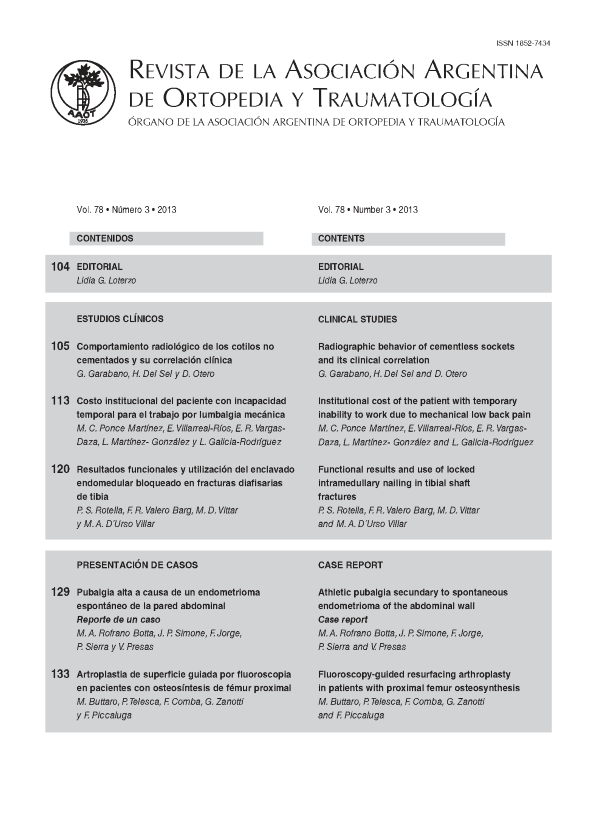Scaffold for bone tissue engineering: superficial modification with zinc. Preliminary study
Main Article Content
Abstract
Downloads
Metrics
Article Details

This work is licensed under a Creative Commons Attribution-NonCommercial-ShareAlike 4.0 International License.
Manuscript acceptance by the Journal implies the simultaneous non-submission to any other journal or publishing house. The RAAOT is under the Licencia Creative Commnos Atribución-NoComercial-Compartir Obras Derivadas Igual 4.0 Internacional (CC-BY-NC.SA 4.0) (http://creativecommons.org/licences/by-nc-sa/4.0/deed.es). Articles can be shared, copied, distributed, modified, altered, transformed into a derivative work, executed and publicly communicated, provided a) the authors and the original publication (Journal, Publisher and URL) are mentioned, b) they are not used for commercial purposes, c) the same terms of the license are maintained.
In the event that the manuscript is approved for its next publication, the authors retain the copyright and will assign to the journal the rights of publication, edition, reproduction, distribution, exhibition and communication at a national and international level in the different databases. data, repositories and portals.
It is hereby stated that the mentioned manuscript has not been published and that it is not being printed in any other national or foreign journal.
The authors hereby accept the necessary modifications, suggested by the reviewers, in order to adapt the manuscript to the style and publication rules of this Journal.
References
2. Liu C, Xia Z, Czernuszka JT. Design and development of three-dimensional scaffolds for tissue engineering. Chem Eng Research Design 2007;85:1051-64.
3. Dorozhkin SV. Bioceramics of calcium orthophosphates. Biomaterials 2010;31:1465-85.
4. Ronen A, Semiat R, Dosoretz CG. Antibacterial efficiency of a composite spacer containing zinc oxide nanoparticles. Proc Engineering 2012;44:581-2.
5. Wang T, Zhang J, Chen Y, Xiao P, Yang M. Effect of zinc ion on the osteogenic and adipogenic differentiation of mouse primary bone marrow stromal cells and the adipocytic trans-differentiation of mouse primary osteoblasts. J Trace Elem Med Biol 2007;21:84-91.
6. Hie M, Iitsuka N, Otsuka T, Nakanishi A, Tsukamoto I. Zinc deficiency decreases osteoblasts and osteoclasts associated with the reduced expression of Runx2 and RANK. Bone 2011;49:1152-9.
7. Yang L, Perez-Amodio S, Barrère-de Groot F, Everts V, Blitterswijk C, Habibovic P. The effects of inorganic additives to calcium phosphate on in vitro behavior of osteoblasts and osteoclasts. Biomaterials 2010;31:2976-89.
8. Peretz A, Papadopoulos T, Willems D, Hotimsky A, Michiels N, Siderova V, et al. Zinc supplementation increases bone alkaline
phosphatase in healthy men. J Trace Elem Med Biol 2001;15:175-8.
9. Ito A, Otsuka M, Kawamura H, Ikeuchi M, Ohgushi H, Sogo Y, Ichinose N. Zinc-containing tricalcium phosphate and related materials for promoting bone formation. Current Applied Physics 2005;5:402-6.
10. Storrie H, Stupp S. Cellular response to zinc-containing organoapatite: An in vitro study of proliferation, alkaline phosphatase
activity and biomineralization. Biomaterials 2005;26:5492-9.
11. Wanga X, Ito A, Sogo Y, Li X, Oyane A. Zinc-containing apatite layers on external fixation rods promoting cell activity. Acta Biomaterialia 2010;6:962-8.
12. Nagata M, Lönnerdal B. Role of zinc in cellular zinc trafficking and mineralization in a murine osteoblast-like cell line. J Nutr Biochem 2011;22:172-8.
13. Toledano M, Yamauti M, Ruiz-Requena ME, Osorio R. A ZnO-doped adhesive reduced collagen degradation favouring dentine remineralization. J Dent 2012;40:756-65.
Pawlig O, Trettin R. Synthesis and characterization of α-hopeite, Zn3 (PO4)2.4H2O. Materials Research Bulletin 1999;34:1959-66.
15. Chao GY. Refinement of the crystal structure of parahopeite. Zeits Krist 1969;130:261-6.
16. Anusavice KJ. Dental cements for bonding applications. En: Anusavice KJ, Phillips RW. Phillips’ Science of Dental Materials, 11a ed. Philadelphia: Saunders; 2003:565-7.
17. Gomes S, Nedelec JM, Renaudin G. On the effect of temperature on the insertion of zinc into hydroxyapatite. Acta Biomater 2012;35:1180-9.
18. Mayer I, Featherstone JD. Dissolution studies of Zn-containing carbonated hydroxyapatites. J Crystal Growth 2000;219:98-101.
19. Ito A, Ojima K, Naito H, Ichinose N, Tateisshi N. Preparation, solubility, and cytocompatibility of zinc-releasing calcium phosphate ceramics. J Biomed Mater Res 2000;50:178-83.
20. Bandyopadhyay A, Withey EA, Moore J, Susmita B. Influence of ZnO doping in calcium phosphate ceramics. Materials Science and Engineering 2007;27:14-17.

